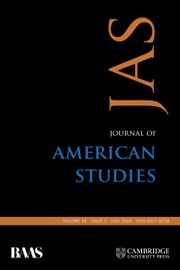In Disenfranchising Democracy, David A. Bateman sets out to reframe our understanding of the changing nature of American suffrage by focussing on the processes by which nonwhites were cut out of the political nation. Bateman's approach to the task begins from the premise that “[d]emocracy and democratization might be productively studied by examining their exclusions,” which in turn “might provide new insights into their occurrence” (xiii). He goes on to explain that “the defining feature of democratization in nineteenth-century America … was the construction of an extensive and vibrant democracy that was simultaneously circumscribed along racial lines, both through the country's heavy reliance on slavery and the constriction of the status of enfranchised citizens to white men” (5).
This recognition of the insider/outside dichotomy in relation to the political community is not in itself new. Nevertheless, Bateman brings a fresh perspective through his comparative approach to the topic which combines local and transnational analysis. After a thorough introduction (a must-read for anyone looking to orient themselves in relation to the historiography of early American democracy), Bateman's work is broken into two parts. The first consists of three chapters which provide a chronological overview of changes to the American franchise between the revolutionary era and the eve of the Civil War. Part Two is made up of chapters analysing similar developments in Britain (1828–32) and France (1870–77).
Part One provides a compelling and incredibly detailed discussion of enfranchisement and disenfranchisement across the US. Bateman takes us down to county and state level to deftly tease apart the local influences on the debate at different times. These case studies are then convincingly connected to the larger national picture of partisanship. Through this approach we see that ideas of enfranchisement and disenfranchisement were not simply imposed from above but instead were a result of various coalitions between local and national interests. In the “White Man's Republic” chapter, he goes on to connect these developments to Jacksonian (and post-Jacksonian) discussions of slavery and abolition. By bringing Britain and France into the discussion in Part Two, Bateman demonstrates the extent to which similar mechanisms were brought into play in the franchise debate on each side of the Atlantic.
Despite clear connections between the US, Britain and France in terms of the processes of enfranchisement and disenfranchisement there are some shortcomings in Part Two of the text. While events in the US are analysed in exceptional detail over 164 pages, developments in Britain and France are covered in sixty-seven and fifty-three pages respectively. Although the analysis remains compelling, these chapters do not contain the same levels of historiographical engagement we find in Part One. The final section on developments in France may also be a little difficult for those who do not already have a grounding in nineteenth-century French political history as it does not contain the sort of orientation regarding local and national power structures which is present in the discussion of Britain. In addition, the decision to break the work into a US section and a non-US section has the effect of hiving off the most intriguing comparative elements of the study.
These potential issues with the structure of the text, however, do not distract from Bateman's broader achievement. The level of detail provided in the US case studies and the compelling analysis which has been undertaken are reason enough to consult the work, even if the comparative elements might have be developed a little further.



